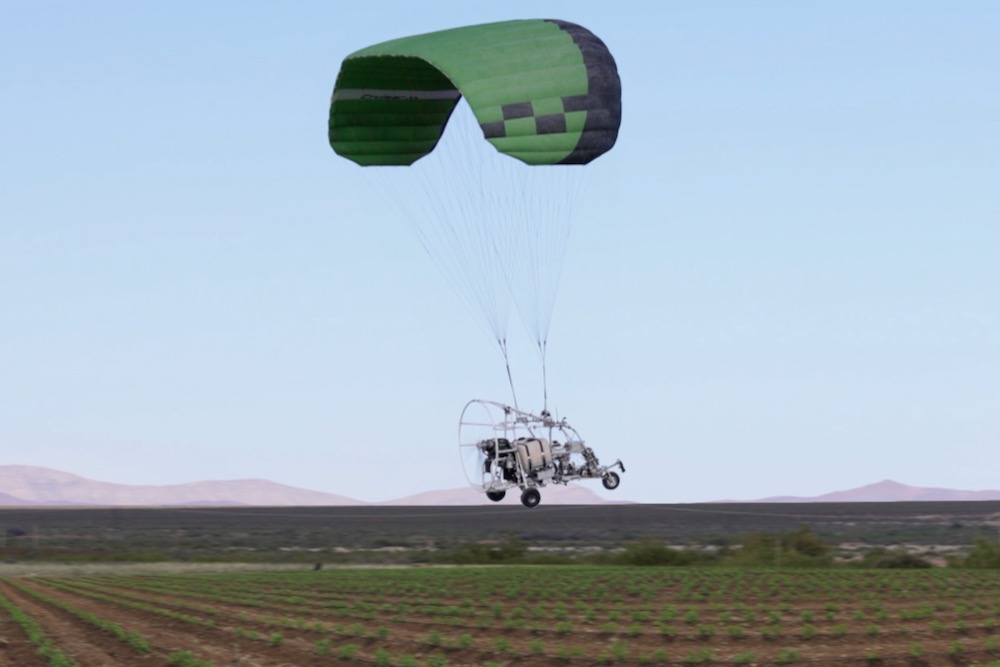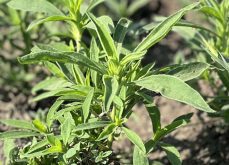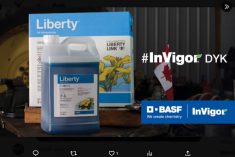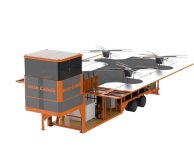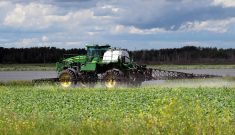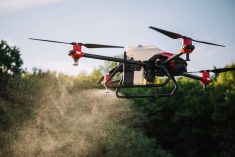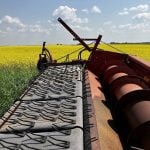For decades, farmers have used boom sprayers in their fields to protect crops from weeds, disease and insect pests. They’ve also relied on crop dusters, which first took flight 100 years or so ago.
The advent of drone technology has ushered in a new age in aerial spraying. Today, the unmanned aerial vehicle (UAV) market is dominated by battery-powered rotary and fixed-wing drones, but there’s a brand-new player emerging that’s unlike any sprayer you’ve seen before.
Developed by Saskatchewan-based Precision AI, the Stratus AirSprayer has a unique “flexwing” design, similar to a paraglider.
Read Also

How much nitrogen can farmers really cut?
Manitoba fertilizer trials seek a sweet spot where farmers can cut nitrogen rates, with a nitrification inhibitor, without hurting yield and with fewer greenhouse gas emissions.
The flexwing refers to a canopy or parachute, attached to a motorized spraying apparatus. The parachute not only provides the necessary lift for the gasoline-powered rig to carry heavy payloads but also enables it to travel at the slower speeds required for precision spraying applications.
“You can’t do any precision work if you’re flying at 100 miles an hour. It just isn’t possible,” says Daniel McCann, Precision AI’s founder and CEO.

The Stratus AirSprayer clocks in at just under 40 m.p.h. as it flies over crops four feet or so above the canopy. It can apply precise GPS-guided broadcast sprays in two interchangeable swath widths, one 18 feet (5.5 metres) wide and the other 30 feet (nine metres) wide.
A Generation Two version of the Stratus AirSprayer, which Precision AI plans to release soon, will feature green-on-green spot spraying technology developed with the use of artificial intelligence and advanced computer vision.
“This is actually the first time this has ever been done from an aerial applicator,” McCann says. “It is actually extremely challenging to develop an aerial platform that can carry a lot of liquid but also fly slow enough so it can be applied precisely. That’s not easy to do.
“We ended up hiring one of the top 10 aerospace guys in the United States (Andrew Streett, now Precision AI’s vice-president of engineering) to help solve this problem. He came up with this idea of using a parachute, which was a new concept that nobody really thought about before,” McCann says.
“It makes perfect sense. Even though it looks a little bit weird, it is probably the most efficient solution for big farms. We’re pretty pleased by it.”
McCann acknowledges the Precision AI team was a bit worried at first about how the UAV’s parachute would go over with farmers, given that it’s so different.
But he says that really hasn’t been a concern, once producers are shown how the Stratus AirSprayer works, and they can see how handling the parachute isn’t any harder than folding and unfolding a spray boom.

Bigger payloads
The drone’s distinctive design means it can carry heavier payloads and stay in the air much longer than other drone sprayers — something McCann maintains is a must for the large farm acreages found across Western Canada.
“We have engineered a really unique concept that can scale up to very large farms,” he says. “Spray drones are great if you have 40 acres of onions or something like that. But if you’ve got 10,000 acres of canola, good luck getting a small drone sprayer to cover that.”
The Stratus AirSprayer, which has a maximum payload capacity of payload of 833 pounds (378 kilograms), can carry 100 U.S. gallons (378 litres) of herbicide, fungicide or insecticide solutions — almost 20 times more than smaller ag drones, according to Precision AI.
The gas-powered AirSprayer can fly up to five hours before refueling, while “your typical spray drones, even the big ones, typically max out at about 10 minutes of air time, then you’ve got to swap batteries and refill it,” McCann says.
“A five-hour flight time means you don’t need fuel infrastructure on site. You might need to fill your spray tank, but you won’t need to refill the fuel.”
McCann says bigger payloads and longer flight times means more efficient spraying — there’s less downtime and more acres covered in a day — as well as substantial savings for farmers due to lower operating costs.
Precision AI maintains it costs less than $3 per acre to operate its UAV, a fraction of the cost of traditional drone technology, which it says ranges from $6 to $13 per acre.

McCann says tests have shown aerial spraying can also provide up to four per cent yield boost over ground applications, because there’s less compaction and crop trampling caused by heavy farm equipment.
He adds conventional ground sprayers also burn more fuel than the Stratus AirSprayer, requiring up to 10 times as much to cover the same number of acres. “You need a lot of gas to run your big iron sprayers.”
McCann maintains the Generation Two AirSprayer should save farmers more money, since its spot spraying system uses less chemicals.
Autonomous operation
The Stratus AirSprayer operates autonomously, both in its flying and spraying capacities.
“You basically upload your field boundaries, and it’ll synthesize a flight map and automatically fly over and spray the field for you. The operator on site just needs to babysit the off button, mostly,” McCann says.
The Canadian government hasn’t yet approved using drones like the Stratus AirSprayer for aerial applications of crop protectant products. Precision AI is on a committee to advise Canada’s Pest Management Regulatory Agency (PMRA) on the necessary changes required to allow spraying from UAVs.
“At the end of the day, we’ve got the technology that can be used as an automated aerial sprayer,” McCann says. “It’s built out, and we just need to wait for the regulatory environment to catch up.”
McCann foresees a time when autonomous drones like the Stratus AirSprayer aren’t constrained by visual “line-of-sight” restrictions.
“When that happens, the AirSprayer theoretically could take off just from your farmyard, fly out to spray a field that might be 10 miles away, then fly home,” he says. “Then you don’t even need to have anybody on site, and that’s really where the power of the extended flight times becomes very powerful. But that’s going to take a few years to get to.”
READ MORE: Herbicide approved for industrial use by drone
McCann adds initial regulation will likely require farmers to attain a drone pilot’s licence to run the AirSprayer — or they’ll need to find a licensed aerial applicator to do it.
“This is a limitation today. But again, we see that changing into beyond line-of-sight world where that won’t be necessary. It’s just not there yet today,” he says.
McCann also sees a day when the Stratus AirSprayer runs on electric power rather than gasoline, once drone batteries become more efficient and last longer before recharging.
“Battery technology continues to improve, but it’s just not good enough to cover big farms yet. But the minute that it does, an electrified future is absolutely plausible,” he says.
“The nice thing about the AirSprayer platform versus the other type of drones out there is it can carry a lot more weight because of that parachute. So, it could actually carry larger batteries that require less downtime, less charging time and so on when we get to that particular phase.”

Less spray drift
The Stratus AirSprayer rig weighs 700 lbs. (318 kg) and measures 3.25 metres (10 feet, eight inches) long, 2.1 metres (six feet, nine inches) wide and 2.25 metres (seven feet, five inches) high. The parachute is 541 square feet (50.3-metres) in size.
“The AirSprayer is actually a very big, heavy vehicle with a lot of inertia. It’s not like a little tiny drone that can get blown off course. If you’re carrying 100 gallons, as an example, you’re operating at about a 1,500-lb. takeoff weight and capacity. That inertia actually makes it less susceptible to wind than you think,” McCann says.
“What we’ve seen is that if you can spray, you can fly. There is a certain amount of wind speed where you just wouldn’t spray anyways, just from drift concerns and a variety of other reasons. So, that’s really the threshold we set for ourselves.”
McCann says the AirSprayer’s downward-facing propellers make it less likely to produce spray drift than rotary ag drones like quadcopters, which “push the spray down and then out to the sides. It’s really difficult to control the drift aspects of that when you’re spraying this way.”
The Stratus AirSprayer can take off from a farmer’s field as long as runway room of 350 to 500 feet (107 to 152 metres) is available. Once spraying is completed, the hardware can be loaded onto a flatbed truck or a 12-foot (3.65-metre) trailer, and the parachute folded and packed up into an easy-to-carry travel bag.
McCann says even with its high-tech capabilities, the AirSprayer isn’t difficult to operate and maintain, adding to its appeal to farmers.
“It’s been designed with the way farmers most typically work, which is give them something that’s easily fixable and that is easily transportable and that doesn’t require a whole lot of storage or maintenance. That’s what we built,” he says.
“I come from a farming family, and most of our team does as well. We understand how this type of thing works. You get your early adopters to try it out, and the minute that they see the results from it, they’re going to tell five of their friends, and they’ll be a great reference for us. That’s kind of how we expect to grow this.”
Value proposition
Janay Meisser, director of innovation for ag co-operative United Farmers of Alberta (UFA), had an opportunity to witness the Stratus AirSprayer in action during Precision AI field testing in New Mexico in May. “I think they’ve got something really special,” she says.
Meisser views the AirSprayer as a good value proposition, both in terms of productivity and return on investment. She also sees it as a very practical solution for farmers looking to get the most out of their crops.
“The Precision AI team is really connected to the farming community and are trying to build solutions for farmers with farmers. I think they’re solving problems that matter,” says Meisser.
“There are a lot of things that make the Stratus AirSprayer unique (and) I think they just got down to brass tacks to determine, what does this (machine) really need to do?” she adds.
“I think it will change how the farming community starts to think about managing crops. It’s going to shift some mindsets.”


